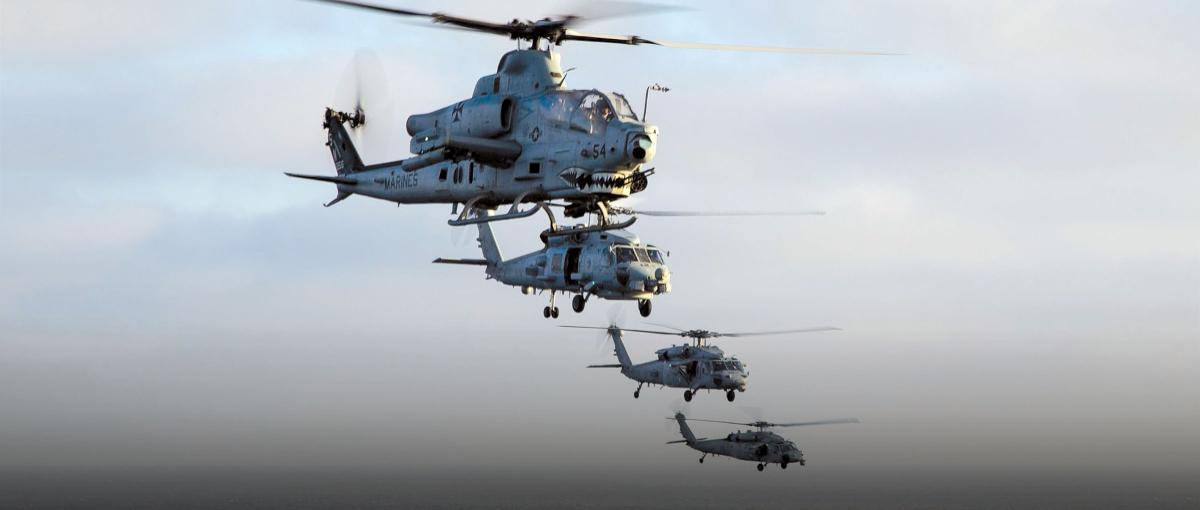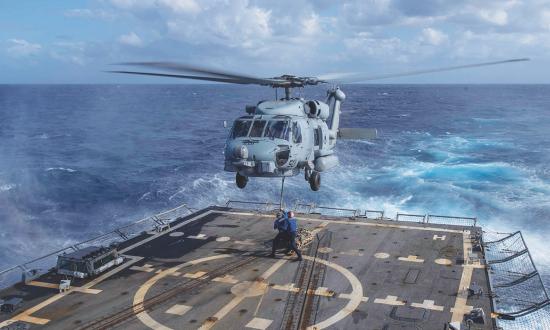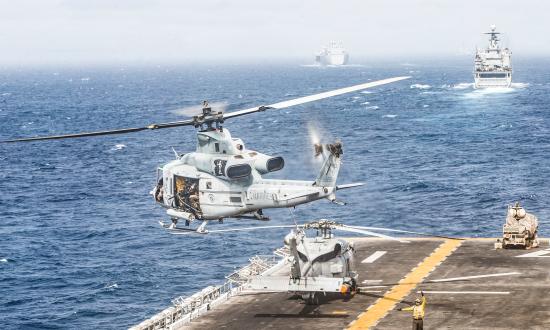When Commandant of the Marine Corps General David H. Berger released Force Design 2030 in March 2020, he left little room for uncertainty about the future of the nation’s naval expeditionary force. Threats rapidly outpacing U.S. military modernization and capacity require the Marine Corps to transform manning, training, and equipping to conform with the imperatives of littoral warfare. General Berger claims this will “demand greater integration with the Navy and a reaffirmation of that strategic partnership.”1
Exercise Trident Storm in July 2020 represented a concerted Navy and Marine Corps effort to transition the fight out of the desert and into the littorals. Trident Storm, informed by the Commandant’s guidance and executed by Navy and Marine Corps rotary wing weapons and tactics instructors (WTIs), highlighted the importance of blue-green training exercises to establish a force “capable of deploying on any Navy ship . . . and ready to respond to a crisis anywhere.”2 The exercise demonstrated the value of Navy rotary wing capabilities to Marine Corps operations, and exposed challenges the Marine Corps will face in integrating with the Navy.
Trident Storm
Exercise Trident Storm encompassed an overwater training period from 24 to 29 July 2020. It began with representatives of Helicopter Marine Light Attack (HMLA) Squadrons 169 and 369, Helicopter Sea Combat Squadron 21 (HSC-21), and Helicopter Maritime Strike (HSM) Squadrons 71, 35, and 79 attending lectures on amphibious ready group/Marine expeditionary unit (ARG/MEU) operations, defense of the amphibious task force, strike coordination and reconnaissance (SCAR), and maritime employment hosted by HSM Weapons School Pacific and HSC Weapons School Pacific.
The briefs presented an opportunity for each Marine Corps and Navy type/model/series WTI to familiarize pilots and crew chiefs on standard operating procedures, capabilities, and limitations of their respective platforms. Many participating aviators had never worked with their sister service counterparts prior to this exercise. The lectures demonstrated not only the similarities in equipment between services but, more importantly, the differences in tactics.
Following the lectures, the Marines observed a Navy restricted-waters transit fleet synthetic training event. Two MH-60S Knighthawk flight simulators linked to one MH-60R Seahawk simulator at Naval Air Station (NAS) North Island. The training exposed the Marines to Navy tactics, techniques, and procedures in the maritime environment and how the composite warfare concept is employed for command and control during ship defense.
On 27 July, HMLA-369 and HMLA-169 returned to NAS North Island to conduct collaborative mission planning with HSC-21, HSM-71, and HSM-79 in preparation for a joint overwater SCAR scenario. The collaborative approach to mission planning ensured sound tactics and risk mitigations and coordination for safe and controlled integration of dissimilar units that had never worked together in confined airspace.
On 28 July, aircrew from HSM-35 and HSM-79 accompanied one MH-60R WTI (SWTI) and one MH-60S SWTI to the Marine Aviation Training Systems Site at Camp Pendleton. The Marines’ simulated environment hosted one AH-1 Cobra and one UH-1 Iroquois performing armed reconnaissance over the course of two events. Navy SWTIs directed the virtual FAC/FIAC threat presentation while acting as sea combat commander to coordinate tasking and authorizations. After each sortie, Navy SWTIs debriefed with the Marines, reviewed tactical decision-making, and provided recommendations for future employment.
A live-flight SCAR event on 29 July culminated the weeklong Marine Corps exposure to Navy overwater tactics. An MH-60S section from HSC-21 armed with 2.75-inch inert unguided rockets, GAU-21 .50-caliber crew-served machine guns, and M240D 7.62-mm crew-served machine guns joined with a mixed section of A/UH-1s from HMLA-169 armed with advanced precision-kill weapon system guided rockets, 20-mm training rounds, and GAU-17 7.62-mm crew-served machine guns to function as armed reconnaissance assets. A MH-60R from HSM-71 acting as SCAR cleared the range with its AN/APS-153(V) multimode radar and populated geolocated target tracks in the Link-16 tactical data link for the MH-60S to engage with pre-planned responses. Because of the lack of Link-16 capability, the Marines passed location information over the radio through Military Grid Reference System coordinates along with bearing and range cuts from an established bullseye reference point. On NAS North Island in the range operations center, HSM and HSC weapons school instructors functioned as the composite warfare commander sea combat commander, communicating with the pilots and tracking the aircraft and training targets.
Blue-Green Training Value
Trident Storm exposed both Navy and Marine Corps aviators to the tactics and training of the other service. At NAS North Island, the Marines learned how preplanned responses and authorization matrices allow for decentralized control and rapid dynamic targeting in the maritime domain. At Camp Pendleton, Navy pilots witnessed the expertise of HMLA pilots and their crew chiefs at employing precision-guided munitions and crew-served weapons when faced with complicated threat scenarios and limited ordnance.
While the exercise paid dividends to all participating units, it also exposed significant limitations for streamlined Navy–Marine Corps overwater integration as envisioned in Force Design 2030. Specifically, the absence of a Marine Corps helicopter tactical data link (TDL) or video downlink (VDL) compatible with Navy shipboard systems and the need for a virtual bridge between services to facilitate aircraft and ship simulators fighting together in a joint synthetic environment.
The lack of Marine Corps rotary wing TDL inhibits UH-1 contributions to rapidly building a recognized maritime picture for the joint force maritime component commander. Passing precise contact information and locations, maintaining awareness of friendly location without terrain reference, discerning hostile intent, and target sorting large groups of FAC/FIAC swarms without TDL or VDL are cumbersome when done over the radio and can lead to confusion. The emissions-controlled battlefields of the future will demand radio discipline and all joint warfighting platforms need the ability to pass secure, real-time data through other means than voice.
The sequence of events from lectures to simulators to live flights revealed opportunities for continued interservice combat preparation. The maritime battlefield requires a shift in armed reconnaissance threat calculus. Multiple high-speed FAC/FIAC with unhindered avenues of approach to friendly surface forces demands a shift in Marine Corps attack aircraft pilot mentality. The close-air support tactics the HMLA community mastered after 20 years of conflict in the Middle East need to be adjusted to meet a maritime threat. Marine Corps tacticians cannot generate this new ship-defense doctrine in a vacuum—it must be generated with Navy surface and air advisors in harmony with Navy tactics, techniques, and procedures.
Force Multiplication
Trident Storm demonstrated that HSC Wing Pacific, HSM Wing Pacific, and Marine Air Group 39 have set the cadence for codified, overwater Navy and Marine Corps partner exercises outside of the Navy’s optimized fleet response training plan. These opportunities extend beyond surface warfare to the entire range of Navy–Marine Corps operations. In Force Design 2030, General Berger acknowledges that the Navy employs “capability not resident with the Marine Corps such as coastal/riverine forces, naval construction forces, and mine countermeasures forces.”3
The sundowning of the MH-53E Sea Dragon heavy lift helicopters by 2025 postures HSC to provide the primary airborne mine countermeasures (AMCM) capability in coordination with littoral combat ships. This opens the aperture for Navy–Marine Corps teaming opportunities with HMLA providing escort and security for HSC (AMCM) operations. The robust MH-60R sensor capabilities afford the ARG/MEU organic situational awareness. Embarking HSM aircraft on board amphibious ships will rapidly shorten dynamic targeting kill-chain timelines for Marine Corps aircraft.
In the potential peer conflict of tomorrow, the Navy–Marine Corps team will stand together on the maritime front lines. While standoff weapon and unmanned systems will provide tactical advantage at the outset of conflict, armed-service solidarity and a foundation of mutual understanding will hold the line. Recognizing the capabilities and limitations of partner service platforms allows both operators and supporting commander staffs to balance
the strengths and limitations of non-organic assets.
Trident Storm displayed a small-scale tactical effort to advance the Navy–Marine Corps dialogue after 20 years of counterinsurgency operations in the Middle East. The force-multiplying benefits of a Navy and Marine Corps in synchronized formation is formidable. This partnership, however, is not a luxury. Great power competition demands it.
1. GEN David H. Berger, USMC, Force Design 2030 (Washington, DC: Headquarters Marine Corps, 2020), 1–16.
2. Berger, Force Design 2030, 3.
3. Berger, 2.






